Functional Behavior Assessment (FBA)
Understanding the Foundations and Practice of FBA
Introduction to Functional Behavior Assessment
Functional Behavior Assessment (FBA) is a critical process used extensively in educational and behavioral contexts to understand and address challenging behaviors. It provides a systematic approach to identifying the root causes of behaviors that may interfere with learning and social interactions. By understanding these underlying functions, educators and behavior specialists can develop effective, individualized intervention strategies aimed at reducing problematic behaviors and promoting positive development.
Definition and Core Principles of FBA
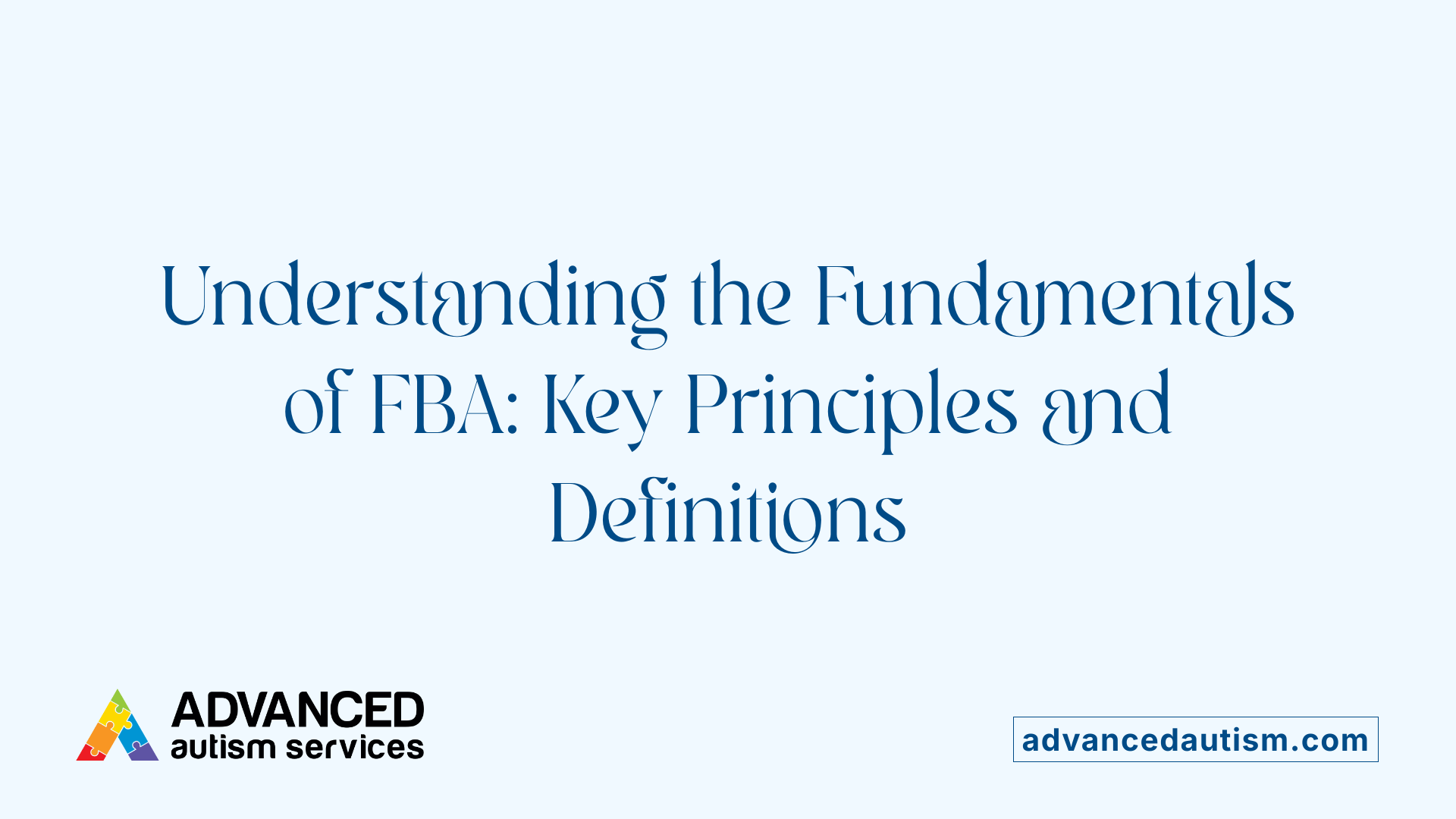
What is a Functional Behavioral Assessment (FBA)?
A functional behavioral assessment (FBA) is a comprehensive process used to understand the purpose behind a student's specific behavior, whether it is academic, social, or emotional. Schools and professionals conduct FBAs to gather detailed information about problematic behaviors to identify what triggers them and what maintains them over time. This process provides a foundation for creating effective intervention strategies tailored to each student's needs.
The assessment involves various steps, including defining the target behavior clearly and observable, collecting data through interviews, record reviews, questionnaires, and direct observations within natural environments. This multi-method approach ensures a full picture of the behavior and its context, allowing for more accurate hypotheses about why the behavior occurs.
Core principles of FBA: behavior is functional, predictable, and changeable
Foundation of FBA lies in the belief that behavior serves a specific function for the individual. Behaviors are considered to be purposeful, serving to obtain something or to avoid an undesired situation. Recognizing that behavior is functional helps professionals understand why certain behaviors occur and that these behaviors can be modified.
The principles assert that behaviors are predictable, meaning that they tend to occur under similar environmental conditions or in response to similar stimuli. This predictability enables educators and behavior specialists to anticipate behaviors and intervene proactively.
Moreover, behaviors are seen as changeable. With a clear understanding of the function and the environmental factors involved, targeted interventions can be designed to replace problematic behaviors with appropriate, more desirable alternatives. This understanding underpins the development of Behavior Intervention Plans (BIPs) that focus on positive reinforcement, skill building, and environmental adjustments.
Standard components and criteria of an FBA
A thorough FBA includes several key components:
- Behavior Definition: Clearly describing the behavior in observable and measurable terms.
- Data Collection: Using indirect methods—such as interviews with teachers, parents, and other caregivers, record reviews, and behavior rating scales—and direct observation to gather data.
- Environmental Analysis: Identifying antecedents (what happens before the behavior) and consequences (what happens after), which influence the behavior.
- Hypothesis Formation: Developing hypotheses about the behavior's function—whether to gain social attention, escape demands, access preferred items, or for sensory regulation.
- Functional Analysis (if necessary): Conducting systematic manipulations and observations to experimentally confirm hypothesized functions.
Legally, under regulations such as IDEA 2004, an FBA is mandated when a student is removed from their regular placement for more than ten days or when dangerous behaviors are observed. The goal remains to develop individualized, evidence-based interventions that promote positive behavior change.
Why conduct an FBA?
The primary purpose of an FBA is to identify the reasons a student engages in challenging behaviors. Once the reasons are understood, educators and behavior specialists can develop effective, sustainable intervention strategies that teach alternative, appropriate behaviors. These strategies often involve modifying the environment, teaching social and communication skills, and reinforcing positive behaviors.
By systematically understanding behavior, FBAs help ensure that interventions are not merely reactive but are strategic, targeted, and ethically sound. They foster a proactive approach to managing classroom behavior and support students' ability to succeed academically, socially, and emotionally.
Purpose and Significance of FBA
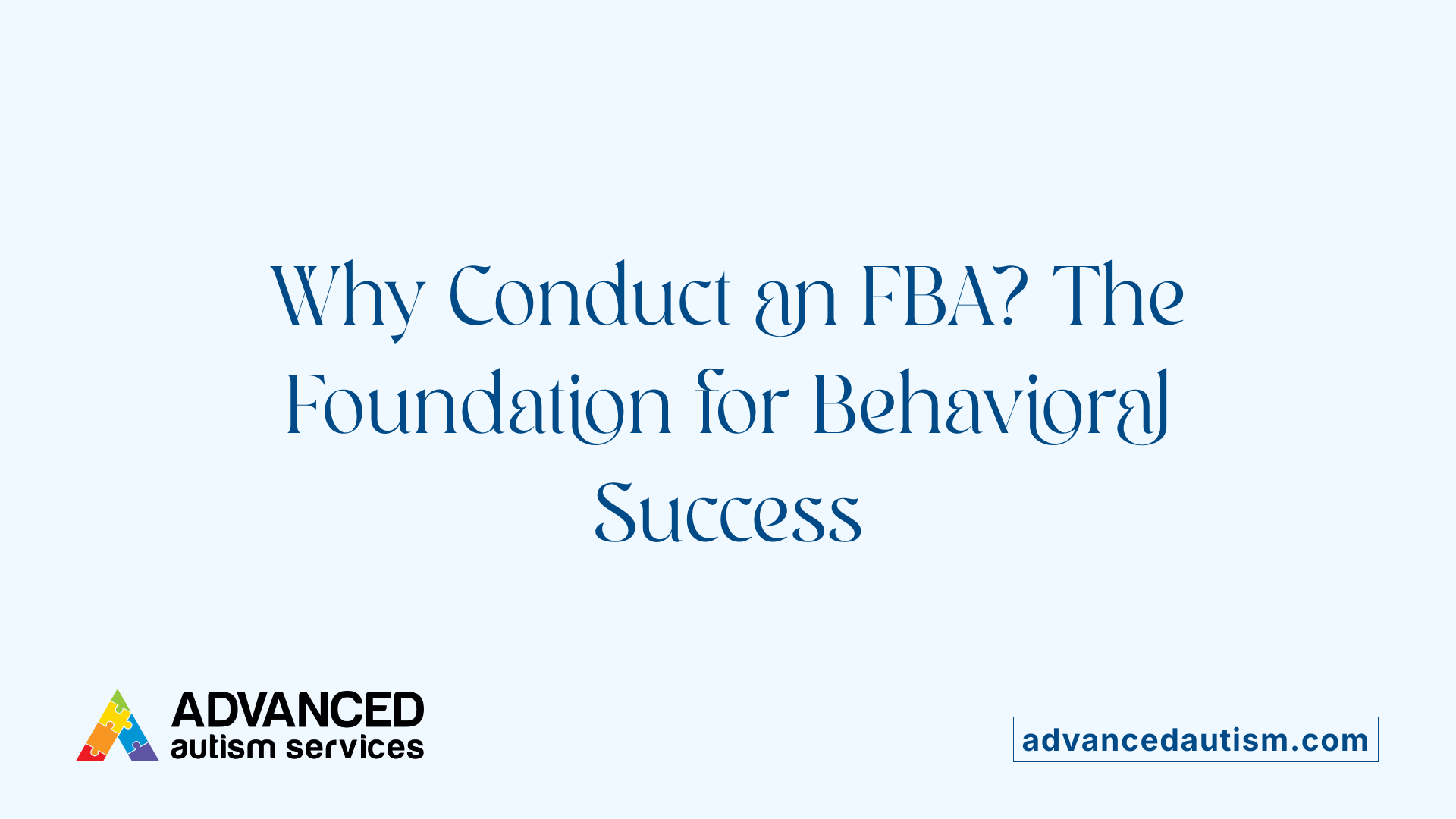
Reasons for conducting an FBA
A Functional Behavioral Assessment (FBA) is conducted to understand the underlying causes of challenging behaviors exhibited by students, especially in educational settings. When a behavior interferes with learning or safety, or when disciplinary measures such as suspension or removal from the classroom are considered, an FBA becomes essential. It provides a systematic way to gather detailed information about the behavior, including the environmental contexts, antecedents, and consequences that maintain it. This process is particularly important for students with disabilities, as mandated by laws such as IDEA 2004, to ensure that interventions are appropriate and effective.
FBAs help identify whether behaviors serve functions like gaining social attention, avoiding tasks or demands, or providing internal sensory stimulation. This understanding allows educators and specialists to design tailored interventions that directly address the function, rather than just the behavior itself.
How FBA informs intervention planning
The main goal of an FBA is to inform intervention strategies that are both effective and respectful of the student’s needs. Once the function of a behavior is identified, a comprehensive Behavior Intervention Plan (BIP) can be developed. This plan includes specific strategies to modify the environment, teach new skills, and reinforce appropriate behaviors.
The data collected during an FBA guide the selection of interventions such as environmental modifications, academic accommodations, social skills training, and counseling. These strategies aim to replace problematic behaviors with more appropriate responses, ultimately promoting positive behavioral change.
The process also emphasizes the importance of positive support. Strategies are focused on least intrusive methods and are grounded in positive reinforcement techniques to encourage desirable behaviors.
What is a functional behavior assessment (FBA) used for?
A functional behavioral assessment (FBA) is used to gather detailed information about challenging behaviors that are academic, social, or emotional in nature. It helps identify the purpose or function that a problem behavior serves for an individual, such as gaining attention, escaping demands, or sensory reinforcement.
The FBA process includes indirect methods like record reviews and interviews, as well as direct observations structured around antecedents, behaviors, and consequences (ABC data). The assessment informs the development of a Behavior Intervention Plan (BIP), which aims to teach alternative, appropriate behaviors and make problem behaviors less effective.
It is a collaborative process involving various team members, including teachers, parents, psychologists, and counselors, and is often mandated by law for students with significant behavioral challenges.
Role and Importance of FBA in Behavior Management
An FBA plays a critical role in understanding and managing student behaviors by providing a detailed analysis of the environmental factors that influence behavior. It ensures that interventions are based on a solid understanding of why behaviors occur, rather than just addressing surface-level symptoms.
By systematically identifying the function of behavior, FBAs make behavior support strategies more precise, effective, and ethical. This assessment process enhances collaboration among team members and promotes positive behavioral outcomes, supporting students’ educational success and emotional well-being.
The Process and Procedures of Conducting an FBA
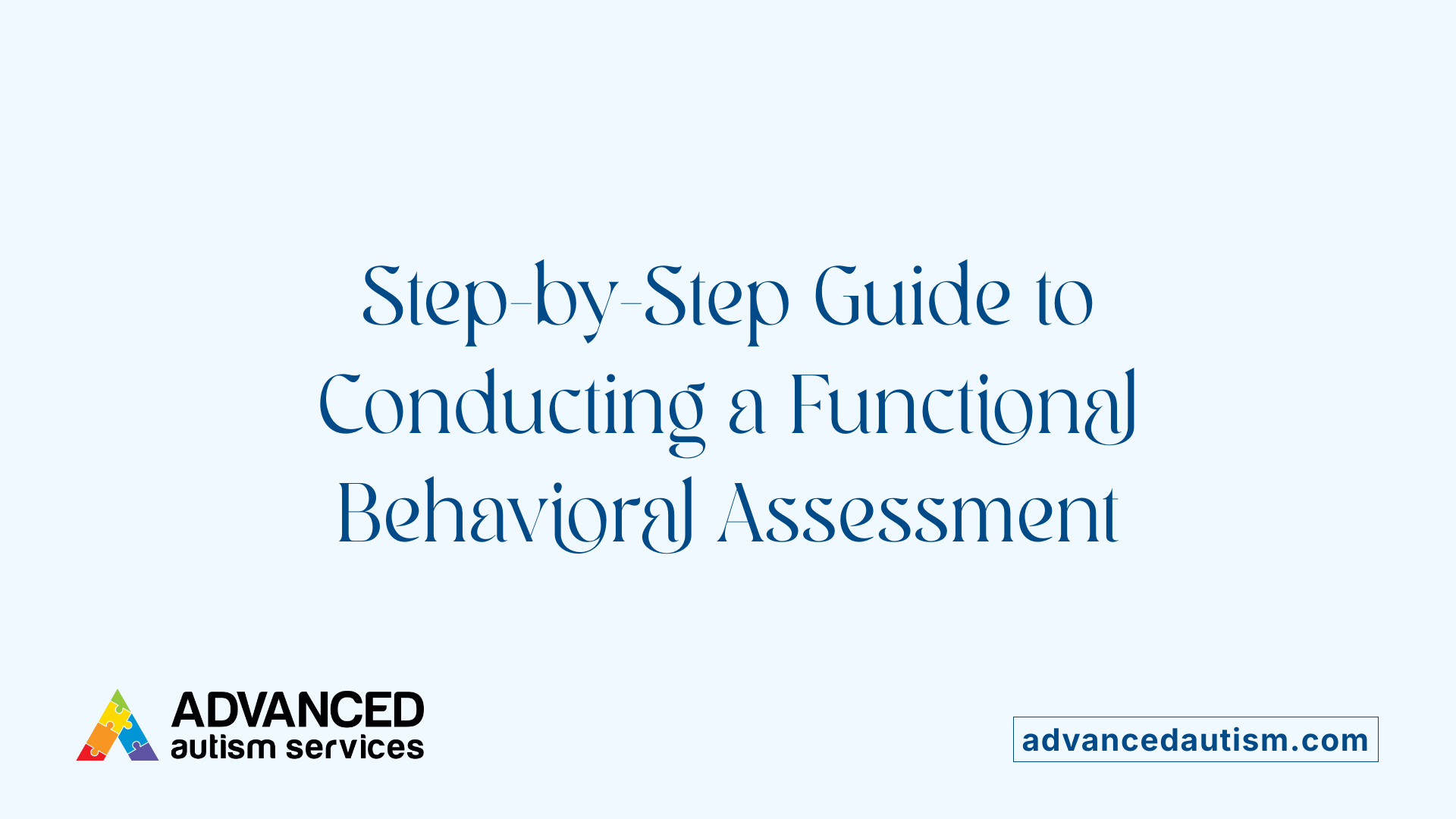
What are the six steps involved in the FBA process?
Conducting a Functional Behavioral Assessment (FBA) involves a systematic process designed to understand and address challenging behaviors. There are six main steps that guide this process.
First, the team collects detailed information about the problematic behavior. This includes specifics such as when and where the behavior occurs, what events happen immediately before (antecedents), what happens afterward (consequences), and who is involved. This comprehensive data forms the foundation for understanding the behavior.
Next, the collected data are carefully analyzed. Tools like the ABC (Antecedent-Behavior-Consequence) model facilitate identifying patterns that may point towards the function or purpose of the behavior. This analysis helps to see if behaviors are maintained by social attention, access to preferred items or activities, escape from demands, or internal sensory stimulation.
Based on this analysis, the team develops a hypothesis regarding the behavior’s function. This hypothesis guides the development of intervention strategies, focusing on addressing the underlying purpose of the behavior rather than just its surface features.
The fourth step involves creating a behavior support plan. This plan contains specific strategies aimed at reducing harmful behaviors and promoting positive, adaptive ones. Techniques might include functional communication training, behavioral replacement strategies, or modifications to the environment to reduce triggers.
Following plan development, the next crucial step is implementation. The intervention strategies are put into practice consistently across settings and by all team members involved in the student’s education and care.
Finally, the team must evaluate the effectiveness of the intervention. Continuous monitoring allows for assessment of whether the behaviors are decreasing or changing as intended. If necessary, adjustments are made to improve outcomes, ensuring that the intervention remains responsive to the student’s needs.
This structured approach ensures that FBAs are thorough, targeted, and effective in promoting positive behaviors in students needing support.
Components and Criteria of an FBA
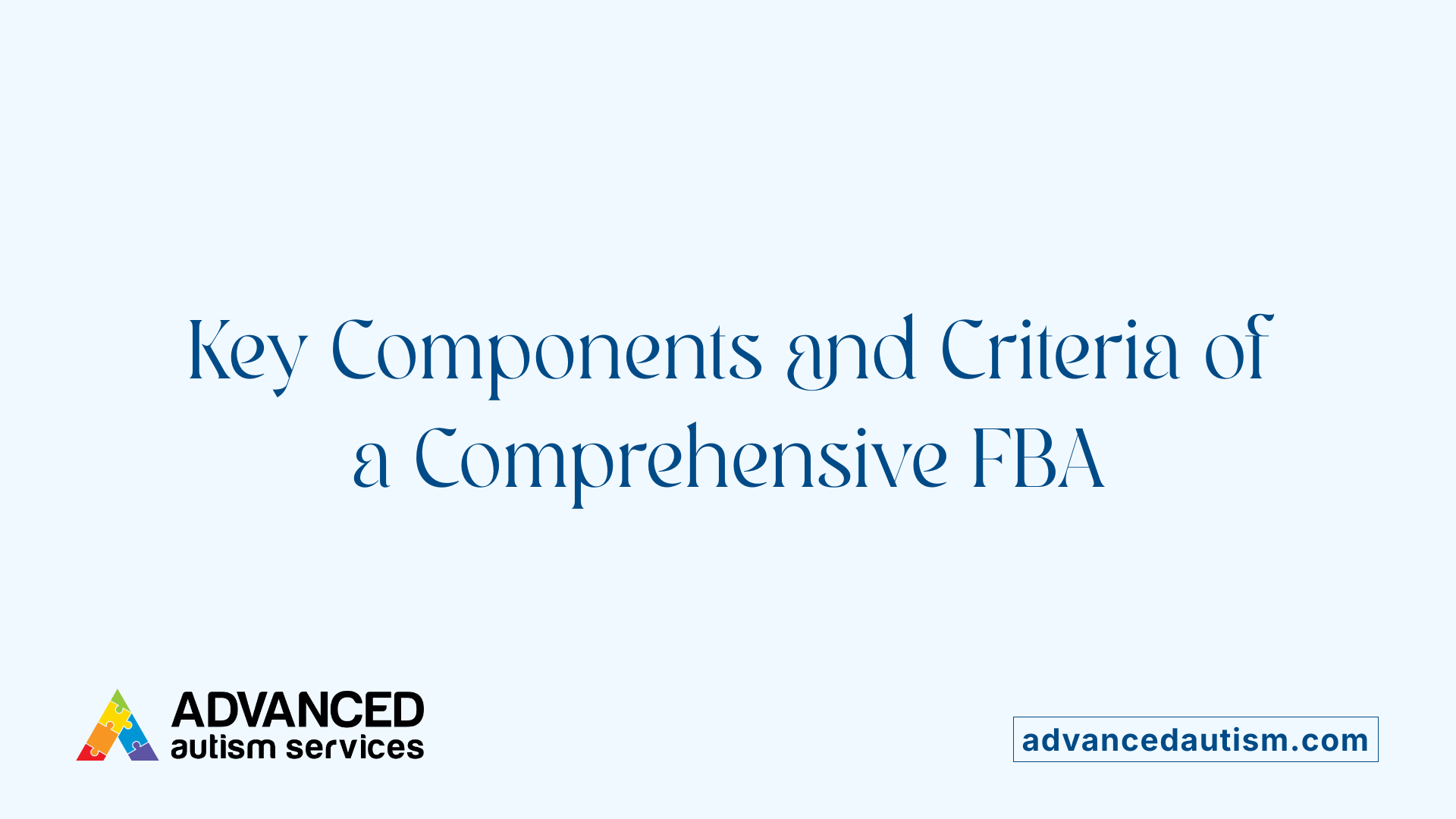
What are the standard components and criteria of an FBA?
A Functional Behavioral Assessment (FBA) is a thorough process used to understand why a student exhibits certain behaviors, especially when those behaviors are problematic or disruptive. At its core, an FBA aims to identify the purpose or function behind the behavior, whether it pertains to academic challenges, social interactions, or emotional issues.
One of the first steps in an FBA is defining the target behavior clearly. This means describing the behavior in observable, measurable terms so everyone involved can recognize and record it accurately. For example, instead of noting
Legal, Ethical, and Regulatory Requirements
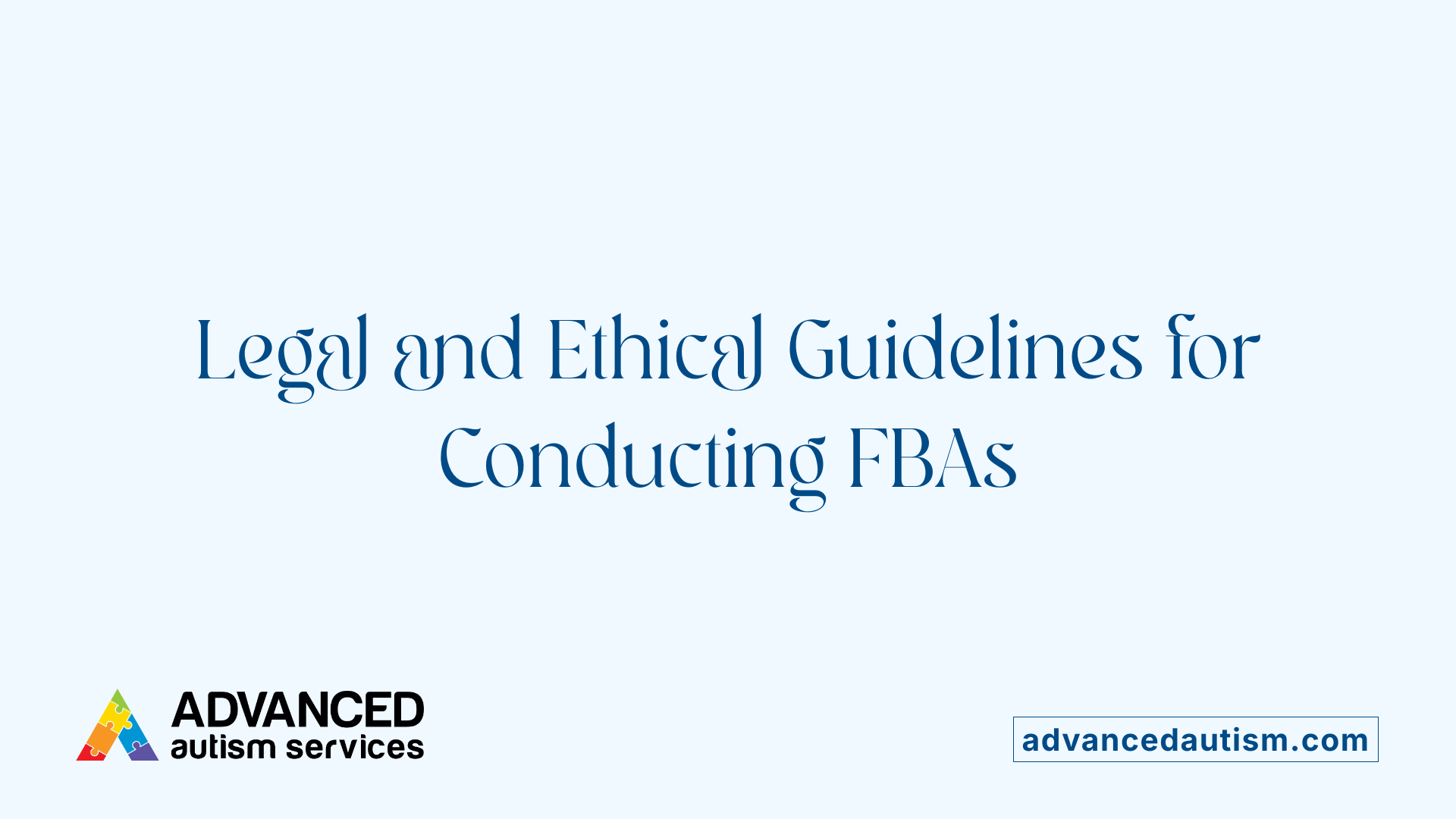
What legal and ethical considerations are associated with conducting an FBA?
When conducting a functional behavioral assessment (FBA), it is crucial to follow established ethical guidelines and legal mandates to protect the rights and well-being of the individual involved. Ethical standards emphasize the importance of obtaining informed consent from parents or guardians before starting an FBA, especially when it involves minors or individuals with disabilities. Respecting the individual's privacy and maintaining confidentiality of assessment data are essential, minimizing the risk of stigma or misuse of information.
Legally, FBAs and subsequent behavior intervention plans (BIPs) are mandated by federal laws such as the Individuals with Disabilities Education Act (IDEA), Americans with Disabilities Act (ADA), and Family Educational Rights and Privacy Act (FERPA). Under IDEA, schools are required to conduct FBAs when behavior impedes a child's learning or safety, particularly if the student has a disability and has been removed from their placement for more than 10 days or faces disciplinary actions that could lead to suspension or expulsion.
Professionals conducting FBAs must ensure that their assessment methods adhere to state-specific regulations, which may set qualifications for who can perform these assessments and how they should be conducted. These practitioners often include trained school psychologists, behavior specialists, or other qualified personnel.
Proper documentation of all assessment procedures, findings, and decisions is vital for transparency, accountability, and legal compliance. Maintaining comprehensive records not only fosters ethical practice but also provides necessary evidence if disputes or legal challenges arise.
In summary, ethical conduct in FBA involves respecting individuals' rights, securing informed consent, and protecting confidentiality. Legally, it mandates adherence to federal and state laws designed to ensure that assessments are conducted fairly, accurately, and in a manner that supports positive behavioral outcomes. Balancing these considerations helps promote valid, respectful, and lawful interventions that effectively address problem behaviors.
Developing Support Plans and Interventions
What is a Behavior Intervention Plan (BIP)?
A behavior intervention plan (BIP) is a tailored strategy designed to address challenging behaviors by teaching and reinforcing more appropriate alternatives. It is developed based on information gathered from a functional behavioral assessment (FBA). The BIP clearly outlines the specific behavior of concern, identifies the function or purpose behind it, and details strategies aimed at modifying environmental factors. The plan includes behavioral goals, intervention procedures, reinforcement strategies, and follow-up steps to monitor progress.
What strategies are used such as reinforcement and environmental modifications?
Reinforcement strategies are central to effective behavior support. Positive reinforcement involves providing rewards or preferred activities contingent on the desired behavior, encouraging its repetition. Environmental modifications include changing the physical or social environment to prevent triggers of problem behaviors and promote positive behaviors. For example, adjusting classroom seating, providing visual cues, or structuring routines can reduce anxiety and improve behavior.
Implementing these strategies requires careful planning:
- Consistently applying reinforcement for appropriate behaviors.
- Using visual schedules to aid understanding.
- Modifying the environment to minimize triggers.
- Providing social skills instruction and counseling as needed.
These approaches work together to create a supportive setting that encourages positive behavioral changes while reducing problematic behaviors.
How can I access resources and guidance on conducting an FBA?
To find helpful resources for conducting an FBA, start by exploring credible online sources such as the U.S. Department of Education’s official guidance document on FBAs. This resource offers comprehensive information on procedures, best practices, and legal requirements. Many educational websites provide downloadable checklists, templates, and step-by-step guides that are useful during implementation.
Professional organizations like the Behavior Analyst Certification Board (BACB) are excellent sources for training materials and resources. Certified behavior analysts (BCBAs and BCBA-Ds) often offer workshops, webinars, and courses focused on FBA procedures. Collaborating with a qualified behavioral specialist ensures the assessment's accuracy and effectiveness.
Attending training sessions and workshops can provide hands-on experience, recent updates, and peer support. Remember, involving trained professionals during the FBA process enhances the quality and reliability of the assessment and subsequent interventions.
Collaborative Role of Stakeholders and Legal Mandates
What role do parents and team members play in the FBA process?
Parents are essential team members in the Functional Behavioral Assessment (FBA) process, offering crucial insights and support regarding the student's behaviors. Their involvement helps to ensure that the assessment accurately reflects the child's day-to-day experiences and environment. Parents contribute by sharing observations, completing questionnaires, and participating in interviews, which are integral to understanding the context and triggers of challenging behaviors.
All members of the Individualized Education Program (IEP) team, including teachers, school psychologists, social workers, counselors, and administrators, share responsibility in conducting the FBA. This collaborative approach allows for pooling diverse perspectives and expertise, resulting in a more comprehensive and effective assessment. Each member provides unique insights based on their interaction with the student, which enhances the accuracy of identifying the behavior's function.
Once the assessment is complete, these stakeholders work together to develop a Behavior Intervention Plan (BIP) that directly addresses the underlying causes of the behavior. This plan might include environmental modifications, social skills training, or academic adjustments, all designed to promote positive behavioral changes.
Legal requirements strongly support this collaborative approach. Under IDEA (Individuals with Disabilities Education Act) 2004, parental consent is necessary before conducting an FBA, especially during initial evaluations or reevaluations. This legal safeguard ensures that parents are actively involved in the decision-making process and agree with the assessment procedures.
Furthermore, federal and state regulations mandate that FBAs be conducted ethically and in compliance with all relevant laws. This includes maintaining confidentiality, using appropriate and respectful assessment methods, and ensuring that interventions are least intrusive and culturally sensitive.
The active participation of both parents and professionals not only promotes ethical standards but also fosters trust and transparency. Their joint efforts lead to more tailored and effective interventions, ultimately supporting the student's emotional, social, and academic success.
Implementing and Evolving Behavior Support Strategies
Monitoring intervention effectiveness
Once a behavior intervention plan (BIP) is in place, continuous monitoring is essential to ensure its effectiveness. This involves regularly collecting data on the student's behaviors and observing any changes over time. Teachers, specialists, and families can use tools such as charting and ABC data collection to track progress. For example, if a student’s disruptive behavior decreases and positive behaviors increase, the intervention might be considered successful.
Regular review meetings help assess the progress and identify whether the strategies are working or if adjustments are needed. These meetings often involve the entire team, including educators, specialists, and parents, to discuss data findings and next steps. Effective monitoring allows for timely modifications, which can include refining prompts, increasing reinforcement for appropriate behavior, or modifying environmental factors.
Adjustments based on data
Data-driven decision-making is vital in supporting behavioral change. When monitoring indicates that behaviors are not improving or have worsened, adjustments should be made. For instance, if a student is not responding to positive reinforcement, the team might examine whether the reinforcement strategies are engaging or if they need to be more immediate or meaningful.
Adjustments might also involve changing antecedent conditions or consequence strategies to better align with the student's needs. For example, if a student continues to escape from difficult tasks, the team might introduce more gradually increasing task demands or provide additional academic supports.
In some cases, data may reveal that the initial hypothesis about the function of the behavior was incorrect. This can lead the team to revisit the FBA process, gather more information, or conduct a functional analysis to clarify the behavior's purpose. The goal is to refine interventions continuously until positive behaviors are sustained.
By consistently reviewing data and making necessary adjustments, schools can create a dynamic support system that adapts to the student's evolving needs and promotes lasting behavioral improvements.
Additional considerations
Implementing effective behavior support strategies requires collaboration among the IEP team, including teachers, school psychologists, social workers, counselors, administrators, and parents. Each member provides valuable insights and judgments based on their observations and knowledge of the student.
Proper training in data collection techniques and intervention strategies ensures everyone is equipped to contribute effectively. Moreover, maintaining a positive and proactive approach helps foster a supportive environment conducive to behavioral change.
Resources for follow-up and support
Research suggests scheduling periodic reviews—monthly or quarterly—to track the impact of interventions, allowing for timely refinements. Use of technology, such as data tracking apps, can facilitate real-time data collection and analysis.
In summary, effective implementation of behavior interventions relies on diligent monitoring and flexible adjustments informed by data. This ongoing process helps ensure that strategies are truly responsive to the student’s needs, leading to meaningful behavioral improvements and academic success.
Summary and Final Thoughts
A comprehensive understanding of the components, purpose, and procedures involved in Functional Behavioral Assessment (FBA) is essential for developing effective behavioral interventions. By systematically gathering data, analyzing behaviors, and considering ethical and legal guidelines, educators and specialists can design appropriate support plans that promote positive behavioral changes. Ongoing monitoring and collaboration among stakeholders ensure that interventions remain effective and responsive to the child's development. Ultimately, FBA forms a vital foundation in creating supportive educational environments that foster both academic achievement and social-emotional well-being.
References
- [PDF] Functional Behavioral Assessment (FBA) and Behavior Intervention ...
- What is a functional behavioral assessment (FBA)? - Understood.org
- [PDF] FUNCTIONAL BEHAVIORAL ASSESSMENT (FBA) PROCESS
- Functional Behavior Assessment | EBSCO Research Starters
- How to Do a Functional Behavior Assessment in ABA
- [PDF] Functional Behavior Assessment (FBA) - ---EBP Brief Packet - ERIC
- FBA - Michigan Alliance for Families
- Functional Behavioral Assessment (Elementary) - IRIS Center







